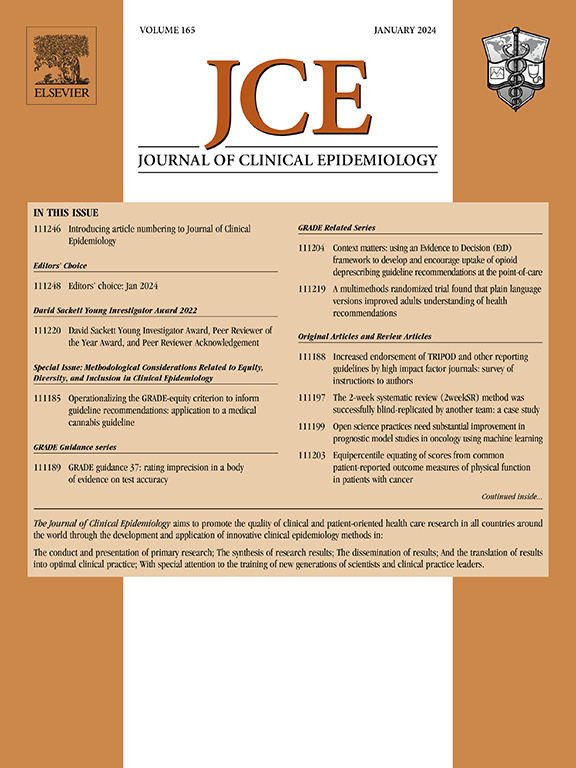Exploring the use and usefulness of living guidelines for consumers: international online survey of patients' and carers' views
IF 7.3
2区 医学
Q1 HEALTH CARE SCIENCES & SERVICES
引用次数: 0
Abstract
Background and Objective
Living guidelines contain continually updated, and potentially changing, clinical recommendations. The implications of living guidelines for consumers (eg, patients, carers, and people with lived experience) - particularly how living guidelines should be developed and disseminated – are yet to be established. The objective of this study was to explore consumers’ views about how best to support the use and usefulness of living guidelines to consumers.
Methods
This study used a qualitative (online survey) design. We invited consumers who were familiar with guidelines (living or conventional) to participate in the study. The survey was distributed globally. Recruitment was conducted via the Australian and international networks of the Australian Living Evidence Collaboration. We invited consumers who were familiar with guidelines (living or conventional) to participate in the study. The survey was distributed globally. Recruitment was conducted via the Australian and international networks of the Australian Living Evidence Collaboration. The 5–10 minute survey collected demographic data then, after introducing the living guidelines concept, asked questions about what living guidelines mean for consumers, how we might make them easy for consumers to find and use, and potential challenges to their use. We analyzed the data using inductive thematic analysis.
Results
Forty-five people (71% women) from 12 countries completed the survey. Participants were enthusiastic about the concept of living guidelines and what they might mean for consumers' ability to make informed health-care decisions and receive best care. They also identified potential challenges related to living guideline dissemination, such as low public awareness of guidelines and confusion about updated recommendations. Participants described practical strategies to support consumers’ awareness and use of, and access to, living guidelines. These included: meaningful involvement of consumers in the development and dissemination of living guidelines; raising awareness by promoting the guidelines widely through trusted health information sources and on social media; and using user-centered formatting and design principles (eg, considering accessibility needs, and publishing lay summaries with plain and culturally-appropriate language).
Conclusion
Consumers suggested a comprehensive range of dissemination strategies to support the use and usefulness of living guidelines to consumers, which largely reflect best practice in conventional guideline dissemination. Promoting and explaining the living nature of guideline recommendations might support their use by consumers. There should also be a close link between the living guidelines and any versions or additional content created for both consumers and clinicians.
探索消费者生活指南的使用和有用性:对患者和护理人员观点的国际在线调查。
背景:生活指南包含不断更新和潜在变化的临床建议。生活准则对消费者(例如病人、护理人员、有生活经验的人)的影响,特别是如何制定和传播生活准则,还有待确定。目的:探讨消费者对如何最好地支持生活指南对消费者的使用和有用性的看法。设计:定性(在线调查)设置和参与者:我们邀请熟悉指南(生活或传统)的消费者参与研究。该调查在全球范围内进行。招募是通过澳大利亚活体证据合作的澳大利亚和国际网络进行的。数据收集和分析:5-10分钟的调查收集了人口统计数据,然后介绍了生活指南的概念,询问了生活指南对消费者意味着什么,我们如何让消费者更容易找到和使用它们,以及使用它们可能面临的挑战。我们采用归纳主题分析法对数据进行分析。结果:来自12个国家的45人(71%为女性)完成了调查。与会者对生活指南的概念以及它们对消费者做出明智的医疗保健决定和获得最佳护理的能力可能意味着什么充满热情。他们还确定了与生活指南传播相关的潜在挑战,例如公众对指南的认知度低以及对更新建议的混淆。与会者介绍了支持消费者认识、使用和获得生活指南的实际策略。这些措施包括:消费者有意义地参与生活准则的制定和传播;通过可信赖的卫生信息来源和社交媒体广泛宣传指南,提高认识;使用以用户为中心的格式和设计原则(例如,考虑可访问性需求,用通俗易懂的语言发布外行摘要)。结论:消费者建议了一系列全面的传播策略,以支持生活指南对消费者的使用和有用性,这在很大程度上反映了传统指南传播的最佳实践。促进和解释指南建议的生活性质可能会支持消费者使用它们。在生活指南和为消费者和临床医生创建的任何版本或附加内容之间也应该有密切的联系。
本文章由计算机程序翻译,如有差异,请以英文原文为准。
求助全文
约1分钟内获得全文
求助全文
来源期刊

Journal of Clinical Epidemiology
医学-公共卫生、环境卫生与职业卫生
CiteScore
12.00
自引率
6.90%
发文量
320
审稿时长
44 days
期刊介绍:
The Journal of Clinical Epidemiology strives to enhance the quality of clinical and patient-oriented healthcare research by advancing and applying innovative methods in conducting, presenting, synthesizing, disseminating, and translating research results into optimal clinical practice. Special emphasis is placed on training new generations of scientists and clinical practice leaders.
 求助内容:
求助内容: 应助结果提醒方式:
应助结果提醒方式:


